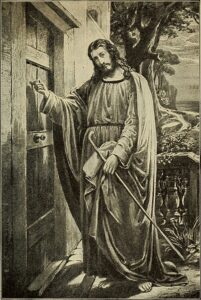“Behold, I stand at the door and knock. If anyone hears My voice and opens the door, I will come in to him and dine with him, and he with Me” (Revelation 3:20).
While Revelation 3:20 is excerpted from “The Revelation of Jesus Christ,” a fitting subtitle for this verse might be, “The Revelation of the Laodiceans.” And much like some other portions of the book of Revelation, this passage reveals something quite unsettling.
 For instance, we might assume that Jesus served as the primary object of worship in the church of Laodicea. But if that was true, then why was He made to wait outside, as implied in the verse quoted above? Furthermore, why did He have to request entry into what was allegedly His church? The most plausible explanation is that this was the church of the Laodiceans, and not Jesus’ church in Laodicea. This likely meant that the church of Laodicea had very little in common with Jesus, except perhaps in name only.
For instance, we might assume that Jesus served as the primary object of worship in the church of Laodicea. But if that was true, then why was He made to wait outside, as implied in the verse quoted above? Furthermore, why did He have to request entry into what was allegedly His church? The most plausible explanation is that this was the church of the Laodiceans, and not Jesus’ church in Laodicea. This likely meant that the church of Laodicea had very little in common with Jesus, except perhaps in name only.
This illustration also offers a broader application. For example, this “door” may serve as a symbolic representation of our innermost being in a spiritual and emotional sense. Since Jesus seeks to establish a sincere, loving relationship with us, He will respectfully decline to enter the lives of those who aren’t willing to open up to Him in faith. Figuratively speaking, He will stand at the threshold of our lives and enter by invitation.
Next, this reference to “dining together” is made easier when we consider the historical practices that typically defined a meal of that era. Then, as now, people usually structured daily mealtimes in three parts. This practice mirrored our contemporary equivalents of breakfast, lunch, and dinner. The first meal often consisted of bread with a filling of fruit, cheese, or olives. We might think of this as a first-century version of a modern-day breakfast sandwich.
Lunch typically included more bread, cheese, seasonal fruits, and olives. Finally, there was an evening meal that was normally eaten near sundown. That menu often featured a stew made from lentils or vegetables along with portions of bread to dip into the stew. This meal was very important from a cultural standpoint, for it offered a time of fellowship and conversation for those who were present.
As everyone ate together, they all received nourishment from the same meal and thus enjoyed a common bond of shared experience. Thus, it was symbolic of two or more people joining together. Jesus used this illustration to help communicate the close, personal relationship that He desires to have with those who open the door of their lives to Him.
Image Attribution: Spicer, William Ambrose, 1866-, No restrictions, via Wikimedia Commons

